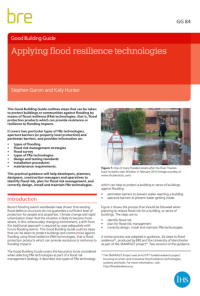Applying flood resilience technologies GG 84
Applying flood resilience technologies (GG 84) was written by Stephen Garvin and Katy Hunter, and published by BRE on 8 September 2014. BRE (Building Research Establishment) is an independent, research-based consultancy, testing and training organisation, operating in the built environment and associated industries.
Recent flooding events worldwide have shown that existing flood defence structures do not guarantee a sufficient level of protection for people and properties. Climate change and rapid urbanisation mean that the situation is likely to become more severe. In this unfavourably changing environment, a shift from the traditional approach is required to cope adequately with future flooding events.
This 12-page Good Building Guide outlines steps that can be taken to protect buildings or communities from flooding through the use of flood resilience (FRe) technologies, that is, flood protection products which can provide resistance or resilience to flooding impacts.
It covers two types of FRe technologies:
It provides information on:
- Types of flooding.
- Flood risk management strategies.
- Flood survey.
- Types of FRe technologies.
- Design and testing standards.
- Installation procedures.
- Maintenance requirements.
This practical guidance will help developers, planners, designers, construction managers and operatives to identify flood risk, plan for flood risk management, and correctly design, install and maintain FRe technologies.
Its contents are:
- Introduction.
- Flood risk.
- Types of flooding.
- Flood risk management strategy.
- Survey.
- Types of FRe technologies.
- Relevant design and testing standards.
- Installation.
- Maintenance.
- References.
- Further reading and information.
[edit] Related articles on Designing Buildings Wiki
- BRE articles on Designing Buildings Wiki.
- BRE Buzz articles on Designing Buildings Wiki.
- BS 851188.
- Building flood resilience.
- Building Research Establishment.
- Catchment flood management plans.
- Flood.
- Flood defences.
- Flood insurance.
- Flood risk management plans.
- Flood risk.
- Future flood prevention.
- Pitt Review.
- Thames barrier.
- Water engineering.
Featured articles and news
RTPI leader to become new CIOB Chief Executive Officer
Dr Victoria Hills MRTPI, FICE to take over after Caroline Gumble’s departure.
Social and affordable housing, a long term plan for delivery
The “Delivering a Decade of Renewal for Social and Affordable Housing” strategy sets out future path.
A change to adoptive architecture
Effects of global weather warming on architectural detailing, material choice and human interaction.
The proposed publicly owned and backed subsidiary of Homes England, to facilitate new homes.
How big is the problem and what can we do to mitigate the effects?
Overheating guidance and tools for building designers
A number of cool guides to help with the heat.
The UK's Modern Industrial Strategy: A 10 year plan
Previous consultation criticism, current key elements and general support with some persisting reservations.
Building Safety Regulator reforms
New roles, new staff and a new fast track service pave the way for a single construction regulator.
Architectural Technologist CPDs and Communications
CIAT CPD… and how you can do it!
Cooling centres and cool spaces
Managing extreme heat in cities by directing the public to places for heat stress relief and water sources.
Winter gardens: A brief history and warm variations
Extending the season with glass in different forms and terms.
Restoring Great Yarmouth's Winter Gardens
Transforming one of the least sustainable constructions imaginable.
Construction Skills Mission Board launch sector drive
Newly formed government and industry collaboration set strategy for recruiting an additional 100,000 construction workers a year.
New Architects Code comes into effect in September 2025
ARB Architects Code of Conduct and Practice available with ongoing consultation regarding guidance.
Welsh Skills Body (Medr) launches ambitious plan
The new skills body brings together funding and regulation of tertiary education and research for the devolved nation.
Paul Gandy FCIOB announced as next CIOB President
Former Tilbury Douglas CEO takes helm.
UK Infrastructure: A 10 Year Strategy. In brief with reactions
With the National Infrastructure and Service Transformation Authority (NISTA).
























